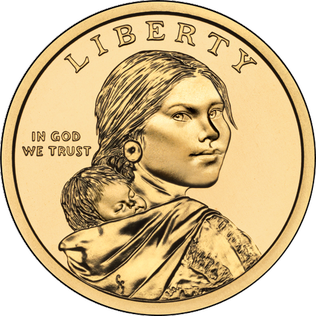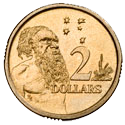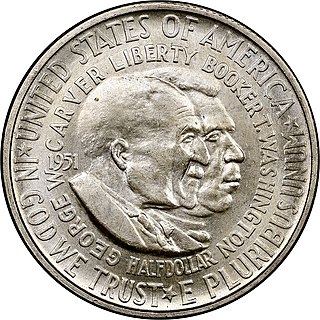In numismatics, the term milled coinage is used to describe coins which are produced by some form of machine, rather than by manually hammering coin blanks between two dies or casting coins from dies.
Mint-made errors are errors in a coin made by the mint during the minting process. Groups of coins with distinctive characteristics are known as varieties. The term variety applies to coins with both intended and unintended differences while the term error refers only to coins with unintended differences. Nevertheless, not all errors are varieties. Although there may be many identical examples of a some errors, others are unique. For example, there may be many indistinguishable examples of coins with a specific die crack, while off-center strikes tend to be unique. Being unique does not mean that an error is valuable. Although no other coin may be similar to a coin with an off-center strike, off-center strikes happen often enough that buyers can choose from many examples each of which varies slightly from the other.

The United States Mint is a bureau of the Department of the Treasury responsible for producing coinage for the United States to conduct its trade and commerce, as well as controlling the movement of bullion. It does not produce paper money; that responsibility belongs to the Bureau of Engraving and Printing. The Mint was created in Philadelphia in 1792, and soon joined by other centers, whose coins were identified by their own mint marks. There are currently four active coin-producing mints: Philadelphia, Denver, San Francisco, and West Point.

The dollar coin is a United States coin with a face value of one United States dollar. It is the second largest U.S. coin currently minted for circulation in terms of physical size, with a diameter of 1.043 inches and a thickness of 0.079 in (2.0 mm), coming second to the half dollar. Dollar coins have been minted in the United States in gold, silver, and base metal versions. Dollar coins were first minted in the United States in 1794. While true gold dollars are no longer minted, the Sacagawea, Presidential, and American Innovation dollars are sometimes referred to as golden dollars because of their color.
A mint is an industrial facility which manufactures coins that can be used as currency.

Counterfeit money is imitation currency produced without the legal sanction of the state or government, usually in a deliberate attempt to imitate that currency and so as to deceive its recipient. Producing or using counterfeit money is a form of fraud or forgery. The business of counterfeiting money is almost as old as money itself: plated copies have been found of Lydian coins which are thought to be among the first Western coins. Before the introduction of paper money, the most prevalent method of counterfeiting involved mixing base metals with pure gold or silver. Another form of counterfeiting is the production of documents by legitimate printers in response to fraudulent instructions. During World War II, the Nazis forged British pounds and American dollars. Today some of the finest counterfeit banknotes are called Superdollars because of their high quality and likeness to the real US dollar. There has been significant counterfeiting of Euro banknotes and coins since the launch of the currency in 2002, but considerably less than for the US dollar.

Coin debasement is the act of decreasing the amount of precious metal in a coin, while continuing to circulate it at face value. This was frequently done by governments in order to inflate the amount of currency in circulation; typically, some of the precious metal was replaced by a cheaper metal when the coin was minted. But when done by an individual, precious metal was physically removed from the coin, which could then be passed on at the original face value, leaving the debaser with a profit. Coin debasement was effected by several methods, including clipping and sweating.
The Seated Liberty portrait designs appeared on most regular-issue silver United States coinage from 1836 through 1891. The denominations which featured the Goddess of Liberty in a Seated Liberty design included the half dime, the dime, the quarter, the half dollar, and until 1873 the silver dollar. Another coin that appeared exclusively in the Seated Liberty design was the twenty cent piece. This coin was produced from 1875 to 1878, and was discontinued because it looked very similar to the quarter. Seated Liberty coinage was minted at the main United States Mint in Philadelphia, as well as the branch mints in New Orleans, San Francisco, and Carson City.
The Hong Kong coinage, including 10¢, 20¢, 50¢, $1, $2, $5 & $10, is issued by Hong Kong Monetary Authority on behalf of the Government of Hong Kong. From 1863 until 1992 these coins were embossed with the reigning British monarch's effigy. From January 1993 to November 1994, a new series depicting the bauhinia flower was gradually issued, including a new denomination of $10. Since the beginning of the coin replacement programme in 1993, over 585 million coins featuring Queen Elizabeth II have been withdrawn from circulation. However, these coins remain legal tender. The total value of coins in circulation in Hong Kong can be found in Monthly Statistical Bulletin and the Annual Report

Columnarios are silver coins that were minted by Spain from 1732 to 1773 throughout its new colonies in present-day Latin America. While the majority of columnarios were struck in Mexico, smaller mints existed in Guatemala; Lima, Peru; Santiago, Chile; Potosí, Bolivia; and Colombia. The base denomination is an 8 reales coin. Other minor denominations included 4 reales, 2 reales, 1 real, and 1/2 real. The 8 reales coin is the predecessor to the American dollar. Before the United States Mint was in production, columnarios circulated, along with other coinage, in the US colonies, as legal tender until the middle of the 19th century.

The Flowing Hair dollar was the first dollar coin issued by the United States federal government. The coin was minted in 1794 and 1795; its size and weight were based on the Spanish dollar, which was popular in trade throughout the Americas.
The Canadian Gold Maple Leaf (GML) is a gold bullion coin that is issued annually by the Government of Canada. It is produced by the Royal Canadian Mint.
This article is a collection of numismatic and coin collecting terms with concise explanation for the beginner or professional.

The Australian two dollar coin is the highest-denomination coin of the Australian dollar. It was first issued on 20 June 1988, having been in planning since the mid-1970s. It replaced the Australian two-dollar note due to having a longer circulatory life. The only "mint set only" year was 1991. The one dollar and two dollar coins are legal tender up to the sum of not exceeding 10 times the face value of the coin concerned.

The 2 euro coin (€2) is the highest value euro coin and has been used since the introduction of the euro in 2002. The coin is used in 22 countries with a collective population of about 341 million. The coin is made of two alloys: the inner part of nickel brass, the outer part of copper-nickel. All coins have a common reverse side and country-specific national sides. The coin has been used since 2002, with the present common side design dating from 2007.
This article provides an outline of the currency of Spanish America from Spanish colonization in the 15th century until Spanish American independencies in the 19th. This great realm was divided into the Viceroyalty of New Spain, which came to include all Spanish territory north of Panama, the West Indies, Venezuela, and the Philippines, and the Viceroyalty of Peru, which included Panama and all Spanish territory in South America except Venezuela. The monetary system of Spanish America, originally identical to that of Spain, soon diverged and took on a distinctive character of its own, which it passed on to the independent nations that followed after.

The United States dollar is the official currency of the United States and its territories per the Coinage Act of 1792. One dollar is divided into 100 cents, or into 1000 mills for accounting and taxing purposes. The Coinage Act of 1792 created a decimal currency by creating the dime, nickel, and penny coins, as well as the dollar, half dollar, and quarter dollar coins, all of which are still minted in 2020.
In minting, coining or coinage is the process of manufacturing coins using a kind of stamping which is now generically known in metalworking as "coining". This process is different from cast coinage, and can be classified in hammered coinage or hammering and milled coinage or milling.
Reeding is a technique wherein "reeds" are carved or milled into a surface.

The George Washington Carver-Booker T. Washington Half Dollar was designed by Isaac Scott Hathaway. The obverse depicts side-portraits of George Washington Carver and Booker T. Washington and the reverse shows a simple outline map of the United States of America superimposed with the letters "U.S.A.", and the words "Freedom and Opportunity for All/Americanism" around the rim. It was minted in silver from 1951 until 1954, by authority of Pub.L. 82–151. It was the final issue of early commemoratives.










